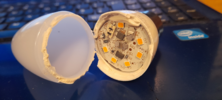With respect I find many LEDs run hotter than the same power incandescent, classic example being 15W SES candle bulb which runs warm - certainly comfortable to touch whereas a 6W LED version runs too hot to touch in the same fitting.
That does not seem right, however just removed a faulty LED bulb and it was very hot, but also clearly faulty.
If a bulb consumes 6 watt, that energy must go some where, it may leave the bulb as light, heat, even radio waves, but it must leave the bulb.
Leaving the bulb as heat circulating air removes the energy, leaving as light, then any surface it hits will turn some of it from light to heat, and the darker the surface the more light is changed into heat.
So the same fitting with LED, CFL, and Tungsten will get hot in different areas, the pearl dome of the LED candle bulb is likely empty,

the chips are before the dome, so the base gets warmer and the plastic which replaces the glass runs rather cool.
Look at a range of LED bulbs and the lumen per watt can vary from 60 - 110, so one LED bulb can end up twice as hot as another with same rating.
But if the shade says 25 watt then that is the limit be it LED, CFL, or Tungsten, it is watts that matter not the lumen.


